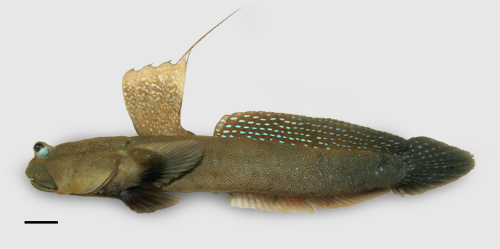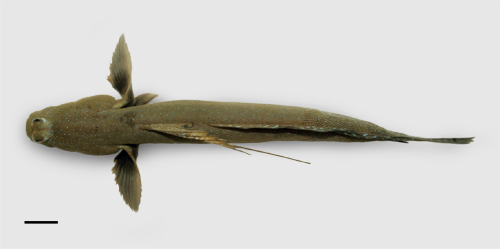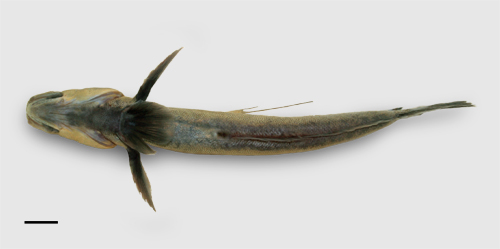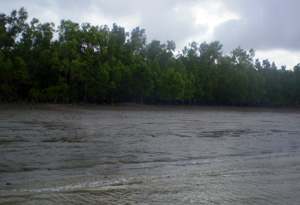|
Synonyms:
Etymology:
'Boleophthalmus' depicts the capability of these fishes to rapidly raise their eyes above the level of their orbits, as if they were ejected out of their orbits: from 'bolê' (ejected), and 'ophthalmôn' (eye) (Cuvier & Valenciénnes, 1837)
'caeruleomaculatus' means 'pale blue-spotted' in Latin, with reference to the numerous speckles on trunk and head
|
Maximum recorded length:
165 mm SL (Murdy, 1989)
Live colouration (Polgar et al., 2010; Takita et al., 2011):
body background colour greenish brown on head, dorsum and flanks, ventrally bluish grey, darker behind anus and on throat; head and trunk
with numerous small sky blue, iridescent speckles; in adults, the epidermis below orbits (dermal cups: Murdy, 1989) is sky blue. D1 greenish with numerous bluish white spots, distally paler; D2 membrane greenish, with columns of sky blue spots between elements;
caudal fin greenish grey with series of sky blue spots;
anal fin hyaline, proximally darker; pectoral fins dusky; basal portions of pectoral rays dark grey; muscular bases of pectoral fins ventrally dark grey, dorsally greenish brown with sky blue speckles; pelvic fins dark bluish grey, proximally darker
Colouration on preservation (Murdy, 1989; pers. obs.: Papua New Guinea, Australia NT):
ground colour brown to grey, with numerous, small, dusky spots on cheeks, opercula, nape and dorsal to pectoral fins. D1 dusky with whitish mottling, distally transparent with dusky margin; D2 brown with columns of blue or brown dash marks on membrane; caudal fin dark brown with series of blue or brown spots on membrane; anal fin proximally dusky, white for the rest; pectoral and pelvic fins dark brown
Diagnosis (Murdy, 1989):
total elements of D2 24-28;
total elements of anal fin 24-27; longitudinal scale count 90-136; predorsal scales 30-53; caudal fin length 18.5-22.7%SL; head length 27.0-29.8%SL;
length of D2 base 43.2-47.9%SL; 1st D2 element usually segmented and unbranched; lower jaw teeth lacking notches (not bifid; Polgar et al., 2013).
Species-specific sexual dimorphism: last two D1 spines more elongated in females (Polgar et al., 2013); sky blue skin of the eyes' dermal cups; shape and colouration of dorsal fins, in larger specimens
(see Boleophthalmus poti, Remarks).
The genus is characterised by the greatly thickened epidermis of the head and dorsum, covered by dermal papillae; and by a rectangular piece of cartilage spanning the width of the
pelvic girdle (see drawing)
Diet:
no published study is available. However, it presents the typical feeding behaviour of other congeneric species (pers. obs.)
Reproduction:
the details of its life
cycle have not been described, but are probably similar to those of congeneric species
(see Reproductive behaviour and
B. pectinirostris); no published study is available
|
Ecological notes (Polgar et al., 2010; Takita et al., 2011):
locally very abundant in front of the pneumatophore zone of mangrove forests and on tidal mudflats
middle: Sisikura Is., Fly river delta, Papua New Guinea: forest marine fringe and adjacent mudflat at low tide; here several specimens were found (photo: G. Polgar, 2007)
|
|
A: a male of B. caeruleomaculatus: note the lack of elongated spines in D1 (photo: G. Polgar,
2007); B: the main entrance of a burrow in front of the pneumatophore zone, nearby a formation of Avicennia sp. (photo: G. Polgar,
2007); C-F: photos of a specimen in aquarium (photos A-F: collected in Sisikura Is., Fly river delta, Papua New Guinea,
2007)
|
Drawings of Boleophthalmus caeruleomaculatus:
above, left: cephalic sensory and nasal pores of Boleophthalmus spp.: an= anterior nostril; ao= anterior
oculoscapular canal pore; pn= posterior nostril (modified from Murdy, 1989)*;
above, right: ventral view of pelvis of B. boddarti (pelvic fin elements removed from left side: modified from
Murdy, 1989): PIC= pelvic
intercleithral cartilage; Plv= pelvis; RC= rectangular cartilage; Plsp= pelvic fin spine* - * with permission
|








